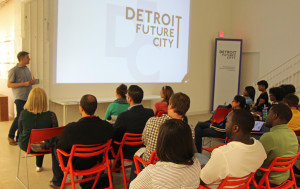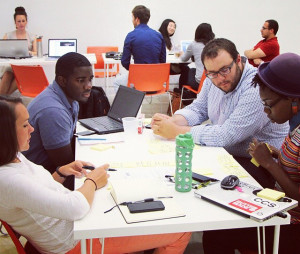How does one improve his/her  own quality of life in the city? What are the proper steps to take in procuring foreclosed parcels? Why does mowing not solve the issue of what to do with areas of blight and brush?
own quality of life in the city? What are the proper steps to take in procuring foreclosed parcels? Why does mowing not solve the issue of what to do with areas of blight and brush?
These were the types of serious and thought-provoking questions that came up in June when the second-year Challenge Detroit fellows partnered with Detroit Future City (DFC) to tackle blight.
Detroit Future City is, at the heart of all of this, a strategic framework for the city’s posterity. The framework covers suggestions that seek to move the meter on economic growth, land use improvement, infrastructure revitalization, and especially blight removal.
With the estimated cost to remove blight from Detroit’s neighborhoods reaching $850M+, there was no better time to divide the Challenge Detroit fellows into six groups, and begin listening and researching alongside the communities for answers.
This was the culminating group challenge for the second cohort of Challenge Detroit fellows, and it was as collaborative as any before it.
In addition to each of the  Challenge Detroit groups having a personal DFC contact, they were partnered with community stakeholders for a particular region in Detroit. The five individual neighborhood partners included: Southwest’s 48217, Jefferson-Chalmers, Warrendale/Warren Ave, Osborn, and Grandmont-Rosedale. The sixth team was our exhibit team, who creatively synthesized and illustrated the work of the others for a window display at the Detroit Future City Implementation Office in New Center, Detroit.
Challenge Detroit groups having a personal DFC contact, they were partnered with community stakeholders for a particular region in Detroit. The five individual neighborhood partners included: Southwest’s 48217, Jefferson-Chalmers, Warrendale/Warren Ave, Osborn, and Grandmont-Rosedale. The sixth team was our exhibit team, who creatively synthesized and illustrated the work of the others for a window display at the Detroit Future City Implementation Office in New Center, Detroit.
The main question that we sought out to solve was this:
How might we improve neighborhood quality of life through participatory approaches to blight elimination?
We knew that each neighborhood would have varying assets and areas for opportunity. Also, a neighborhood’s population ended up having a determining factor in how we might engage the community to take action against blight.
Proposed solutions for a diverse area such as Warren Ave, with booming populations of youth and renters may not be as advantageous as those proposed for Grandmont-Rosedale, with its pocketed areas of blight and single-family housing stock.
The timeline for the entire  project was a mere five weeks, so our teams needed to well organized and deliberate throughout their process.
project was a mere five weeks, so our teams needed to well organized and deliberate throughout their process.
At Challenge Detroit, we use a design thinking process methodology based on and popularized by the d:School Institute of Design at Stanford. The steps include: Empathize, Define, Ideate, Prototype, and Test.
We fulfilled this process with a deep-dive breakfast on blight with DFC and our neighborhood stakeholders, during the first week of the challenge.
During week two, all of our fellows received tours of the areas they would be working with, and saw the unique issues that each community faced.
Throughout week three,  our teams began by taking their prototyped solutions to DFC for in-depth feedback sessions.
our teams began by taking their prototyped solutions to DFC for in-depth feedback sessions.
In the fourth week – the final week before presentation—our teams continued to refine their prototypes and tested them against peer review from other groups. And during week five, we presented our findings and unveiled the window display created by the Exhibit team.
Blight is not a problem that can be solved in five weeks. We just hope that our DFC framework-inspired suggestions can help to promote positive results in the neighborhoods for the betterment of all individuals.
Contributed by Project Managers Cody Grant and Calyssa Lawyer.
